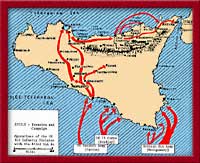
SICILIAN CAMPAIGN
DRIVE TO PALERMO
 After the ancient city of Agrigento was
captured by a battalion of the 3rd Division’s 7th Regiment against strong resistance
and artillery fire plus attacks by Italian planes, enemy forces began to withdraw
northward fighting stubborn but ineffective rearguard actions. Enemy mine fields were
poorly laid and road blocks were not well defended. Many anti-tankguns were not well used
in defense and as U.S. forces prepared to mount their drive to Palermo on the north coast
of Sicily, a number of disturbing air attacks occurred. On both 13 and 14 July, 443rd
Batteries B and C reported bombing and strafing of friendly troops by American P-51s and
P-38s. During 15 July on three different occasions a total of 13 P-51s strafed U.S.
Infantry. Angry protests to higher headquarters served to end these incidents. In
preparing to move to join the Division’s attached 36th Field Artillery, a gun-track
of Platoon D-2 overturned when it was being moved out of its position on a precipitous
slope. One man was injured and hospitalized. After the ancient city of Agrigento was
captured by a battalion of the 3rd Division’s 7th Regiment against strong resistance
and artillery fire plus attacks by Italian planes, enemy forces began to withdraw
northward fighting stubborn but ineffective rearguard actions. Enemy mine fields were
poorly laid and road blocks were not well defended. Many anti-tankguns were not well used
in defense and as U.S. forces prepared to mount their drive to Palermo on the north coast
of Sicily, a number of disturbing air attacks occurred. On both 13 and 14 July, 443rd
Batteries B and C reported bombing and strafing of friendly troops by American P-51s and
P-38s. During 15 July on three different occasions a total of 13 P-51s strafed U.S.
Infantry. Angry protests to higher headquarters served to end these incidents. In
preparing to move to join the Division’s attached 36th Field Artillery, a gun-track
of Platoon D-2 overturned when it was being moved out of its position on a precipitous
slope. One man was injured and hospitalized.
The drive to Palermo progressed so rapidly, against light and sporadic resistance, that
American artillery was often unable to get into firing position before being ordered to
continue the advance. So rapid was the American advance that few of the enemy were able to
escape capture. Enemy air activity began to moderate and considerable equipment was
abandoned by the retreating enemy. Mine fields and road blocks, intended to delay the
Allied advance, were poorly defended. Many anti-tank guns, when captured, were found never
to have been fired. One of the captured pieces was a half-track with a 40 mm gun mounted
on it — suggesting that the German Ordnance people had tried to make use of the
T-28-E1s, captured in Tunisia, to develop a similar weapon. German pilots often referred
to the T-28-E1 as the "hornets’ nest", and no doubt the captured gun-tracks
were the object of much testing and speculation by the Germans. The one captured in Sicily
did have a gun platform, leveling mechanism which the T-28-E1 did not have. No weapons of
this type were seen subsequently.
At frequent halts, during the campaign, 443rd men would occasionally listen to Axis
Sally broadcasts. She had little effect on American morale. 443rd men made her the butt of
jokes, scorned her amateurish, treasonable talk, and laughed at her obvious half-truths or
outright lies. But they did enjoy the music she played.
The rugged but beautiful Sicilian countryside became more so as the advance to Palermo
continued. The sere and dry conditions of the south changed to a more lush and greener
land in the north. Speed of the American advance saw the 3rd Division Headquarters moving
three times in one day — from Aragona to San Stefano, to Prizzi and to Corleone. On
22 July most of the resistance in the 3rd Division sector collapsed and Palermo was taken,
unopposed, on 23 July. It is interesting to note that at 2:45 pm on 23 July, 7th Army
Commander Patton issued orders for all troops to hold their advance, at the Villabate -
Belmonte - Monreale line, until further orders. This action enabled Patton’s own 2nd
Armored Division to enter Palermo first. In Palermo, the usual looting of warehouses was
under way and continued until military intervention stopped it. The usual, systematic
confiscation of food and other supplies had left the Sicilians with lack of many
foodstuffs and no love for their German "allies".
|